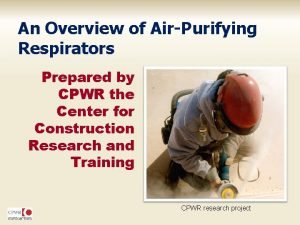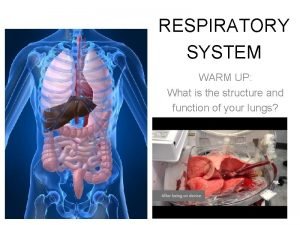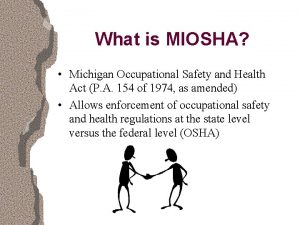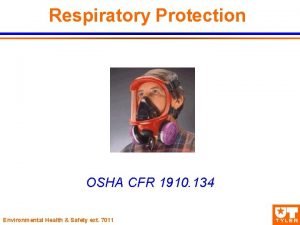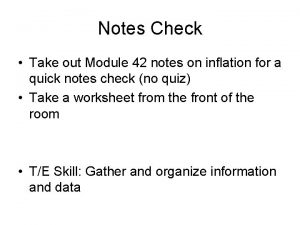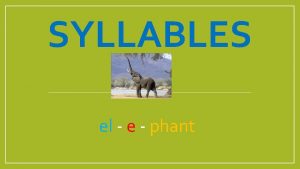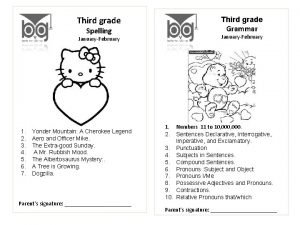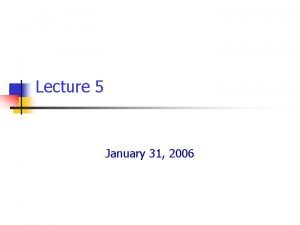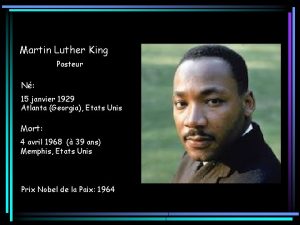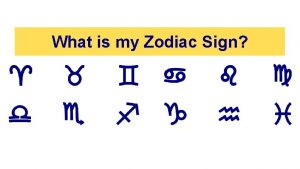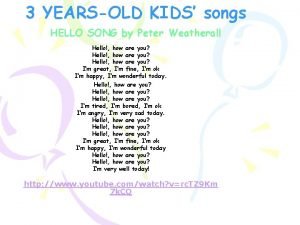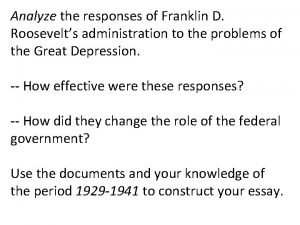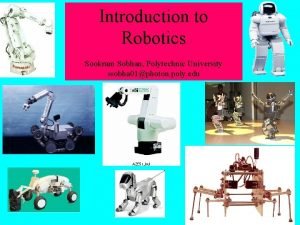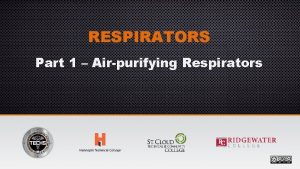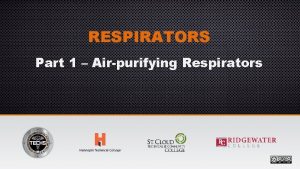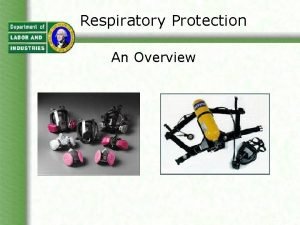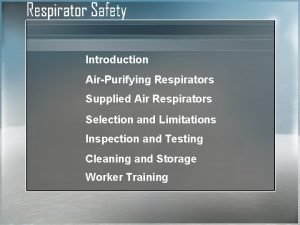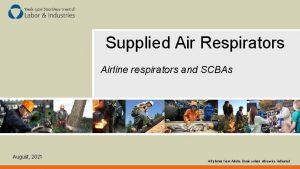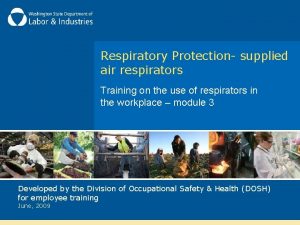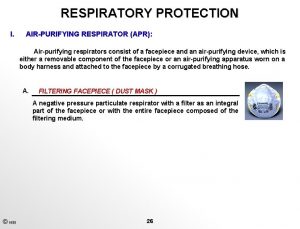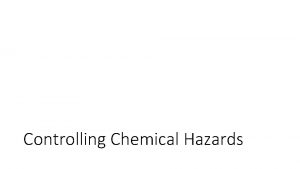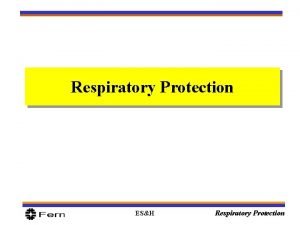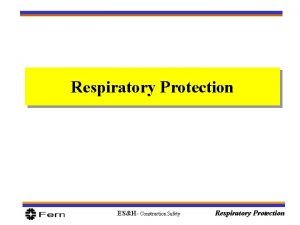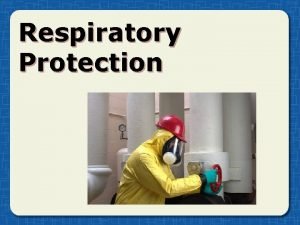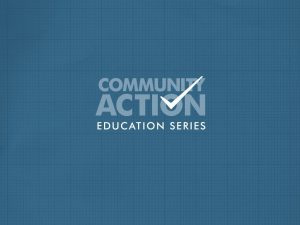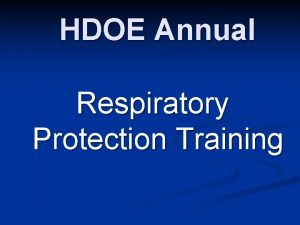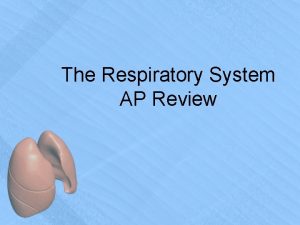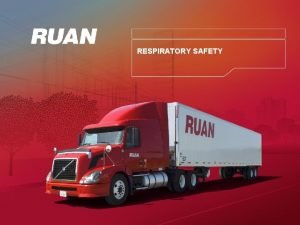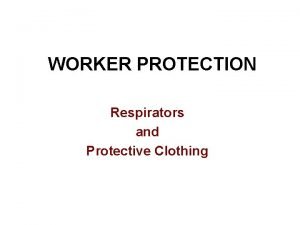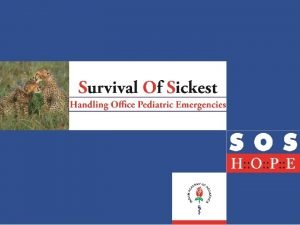Respiratory Protection An overview of respirators January 2011


































- Slides: 34

Respiratory Protection An overview of respirators January, 2011

Respiratory Protection This presentation will cover the following: When respirators are needed Types of respirators and their limitations What you must do when respirators are required What you must do when respirators are optional (worn voluntarily) Note: this presentation gives general information on respirators. Some details are in yellow boxes at the bottom of each slide, in the Power. Point speaker notes or in links.

When Are Respirators Needed? In an oxygen-deficient atmosphere When chemical “Permissible Exposure Limits” are exceeded When required by a pesticide label In situations where air contamination is suspected, but levels are unknown (for example: confined spaces, large chemical spills, hazardous waste sites) When you require it by company policy Normally, an oxygen deficiency will only be found in a confined space or a major chemical leak or spill. Permissible exposure limits are covered in following slides. There are only a few pesticides that have label requirements for respirators. Some employers require their employees to wear respirators as a safety precaution even though they may not be required by DOSH

Oxygen Deficiency Oxygen deficiency can occur in confined or enclosed spaces, during fires or large chemical releases. Normal air contains 21% oxygen. An area with oxygen content below 19. 5 % is considered “oxygen deficient”. Only a supplied air respirator can protect against the effects of oxygen deficiency. 21% 19. 5% 8% Immediate death Oxygen content Oxygen deficiency exists 0%

Permissible Exposure Limits (PELs) for toxic chemicals and dusts Most chemicals and dusts have limits in the air that will cause adverse health effects if exceeded. If airborne levels cannot be reduced below these limits by other means, respirators must be provided to protect exposed employees. There about 600 chemicals with listed permissible exposure limits in DOSH regulations. Most of these limits are based on 8 -hour average exposures, but some have short-term exposure limits based on 15 minute exposures. A few have ceiling limits, which can’t be exceeded even for an instant. The limits are based on the levels at which harmful effects are first know to occur. Link to DOSH PEL Table for Airborne Contaminants

Why Respirators Are the Last Choice Respirators have major limitations: ü They can leak, wear out, or be the wrong kind ü They can be hot, uncomfortable and make it hard to see or communicate ü They can be hard to breathe through ü They are easily removed in contaminated air The first choice is to reduce chemical exposure by other means. Most people do not like wearing respirators and may remove them to talk to another worker. Tight-fitting respirators are especially susceptible to leaking.

How to Avoid Using Respirators Use one or more of the following controls to reduce exposure to airborne chemicals: ü Ventilation ü Dust suppression with water ü Eliminate use of chemical ü Substitute with a less toxic chemical ü Isolate or enclose the chemical processes ü Other processing changes Respirators should be used only if these methods are not feasible or don’t reduce exposure.

Types of Respirators Air-purifying respirators – filters air through cartridges or filtering facepieces (dust masks) Powered air-purifying respirators – filters air through cartridges with assistance of a blower. Airline respirators – provides unlimited clean air from a compressor. Self-contained breathing apparatus (SCBA) – provides 30 - 60 minutes of clean air from a tank. Escape respirators – provides air for escape only from a small bottle.

Types of Air-purifying Respirators Filtering facepiece (dust mask) Full-face cartridge respirator Half-face cartridge respirator Powered air-purifying respirator

Air-Purifying Respirators Air-purifying respirators trap air contaminants in a cartridge or filter when the wearer inhales. Particulate respirators capture dusts, mists and welding fumes. Chemical cartridge respirators capture gases and vapors. Combination cartridges are available. These type of respirators have many limitations and restrictions and cannot be used where air contaminant levels are extremely high or when there is an oxygen deficiency.

How Cartridge Respirators Work Air inhaled in Air exhaled out This picture shows how air moves in and out of the respirator. The act of breathing creates a negative pressure inside the mask, which is why these and dust masks are sometimes called “negative pressure respirators”. If the mask does not fit properly along the edges, contaminated air can enter during inhalation.

Air-purifying Respirator Limitations Cartridges must be changed periodically to provide protection. The right cartridge for the contaminant of concern must be chosen. Air-purifying respirators provide protection up to 10 or 100 times the PEL. Will not provide adequate protection in confined spaces, major leaks or spills or for certain highly toxic chemicals. Respirator cartridges are color-coded for the type of chemical or dust they protect against.

Respirator Protection Factor Air-purifying Limitations Half-face cartridge and dust mask respirators only provide protection to levels 10 times above the chemical or dust permissible limit. Example Ammonia Permissible Limit – 25 ppm = parts per million Respirator Protection Factor for ammonia – 250 ppm

Limits of Chemical Cartridges Chemical cartridges can absorb only so much chemical. When their capacity is reached, breakthrough will occur. You can’t always tell if a respirator leaks by a chemical odor. Some chemicals have no odor, or can only be smelled at high levels. Breakthrough means the chemical goes through the cartridge into the facepiece. If a worker smells the chemical with their respirator on, they will know it is not working. But if the chemical has no odor, or it can only be detected at high levels above the permissible limit, they may not know if your respirator is working properly. For these reasons, cartridges must be changed regularly.

Supplied Air Respirators Airline Respirator SCBA Clean air comes from a compressor or tank and provides the highest protection to users. Supplied air respirators can provide protection up to 1000 to 10, 000 above the permissible exposure limit, depending on the type of respirator. The two types of respirators shown here have tight-fitting facepieces. Loose fitting respirators are also available.

Loose-fitting supplied air respirators Hood facepiece Helmet Full Body Suit Air is supplied from these respirators by means of a hose from an air compressor. These are the only type of respirators that do not require fit-testing. Their protection varies depending on the type. The loose-fitting facepiece is the least protective of this type.

When Are Supplied-air Respirators Required? ü Oxygen deficiency ü High levels of toxic chemicals in the air – above “IDLH” levels ü Other conditions of high levels of highly toxic chemicals in the air ü Firefighting Unlike air-purifying respirators (cartridge-type respirators or dust masks), supplied air respirators provide a high degree of protection for the user in these life-threatening situations. If air contaminant or oxygen levels are unknown and testing can’t be done in confined spaces, emergency spills or leaks or at hazardous waste sites, it must assumed that IDLH levels are exceeded and supplied air respirator must be worn. Assume the worst case, unless you have evidence otherwise.

What is “IDLH”? “IDLH” means immediately dangerous to life or health Most chemicals have a listed IDLH level link to NIOSH IDLH Table Oxygen deficiency is also IDLH conditions can occur in confined or enclosed spaces, large chemical spills or leaks and fires In most workplaces, IDLH conditions rarely occur. Confined spaces are the exception - IDLH conditions are much more common in sewers or tanks where welding is done or which contained chemicals or fuel.

Escape Respirators Escape bottle attached to airline respirator system Carried escape respirator These can’t be used for entry – going in a room to turn off a valve or make a repair. They only contain 5 -10 minutes supply of air, enough time to exit a room or building where there has been a major chemical leak or spill, or when the supplied air respirator fails.

Air Quality for Supplied Air Respirators Air for tanks or from compressors must be “Grade D” air. Tank air is purchased from vendors. Compressors supply air for airline respirators. Compressor air must be equivalent to Grade D air. Low pressure compressors may not provide adequate amount of air. Link to Grade D air requirements

Construction & Plant Air Compressors Use these compressors with caution! Be careful – these do not provide clean air without a filter system!! Oil-lubricated compressor are especially hazardous. You must test for carbon monoxide or have a high temperature alarm. Locate air intake away from engine exhaust which can contaminate breathing air.

Respirator Selection One of the most important task is selecting the correct respirator for the hazard. Knowledge of chemical identity, extent of use, levels in the air and permissible limits is needed. You must conduct a workplace hazard assessment – air sampling may be necessary. Personal air sampler

Respirator Selection Conditions IDLH conditions or oxygen deficiency Type of Respirator SCBA or airline respirator with escape bottle Dust/chemical levels up to 1000 Airline respirator with full times PEL facepiece or hood Dust/chemical levels up to 100 times PEL Air-purifying respirator with full facepiece Dust/chemical levels up to 50 times PEL Powered air purifying respirator with half facepiece Dust/chemical levels up to 10 times PEL Air-purifying respirator with half facepiece

Respirator Fit-testing must be done before Respirators Must Fit Properly first wearing a tight fitting respirator. Tight-fitting respirators must fit properly to prevent leaks around the edges. Beards are not allowed when wearing a tight-fitting respirator because they will leak. Fit-testing must be repeated annually and for any new respirator.

Respirator Fit-testing Checking fit of respirator on individual employees Required for all tight-fitting respirators. Four qualitative methods and three quantitative – your choice. Quantitative methods are more accurate. Fit-testing methods are covered in detail in the Respirator Rule. Link to fit-testing methods

Medical Evaluations Medical evaluations are required for anyone wearing respirators. Respirator use places a burden on the body. Respirators can be hazardous to people with heart or lung problems. Air-purifying respirators restrict breathing, particularly during heavy exercise. They also can add to heat stress in hot conditions. Tank-type respirators (SCBAs) are heavy. Airline respirators and PAPRs are less of a burden to the body.

Medical Questionnaire First step in medical evaluation is a confidential medical questionnaire. Employee completes it and sends it directly to medical provider. Medical provider decides if medical exam needed. The results are only used to determine if respirators can be worn. The information in this questionnaire and the medical exam can’t be shared with the employer. An employer will only get a notice stating the employee can or cannot wear respirators.

Respirator cleaning & maintenance Respirators must be cleaned, inspected and maintained regularly. Respirator maintenance and repair are essential for proper functioning. Store in a clean, dry place. Cartridges are not cleaned, only disposed. Regular cleaning is especially important in dusty conditions. Don’t store like this!

Employee Training is required for any employee wearing respirators. Training must cover why respirators needed, their limitations, how to clean and maintain and how to use. Hands-on training is especially important for emergencies and SCBA use. Some respirator vendors will provide training. We also has respirator training programs on our webpage, with link below. Link to respirator training modules

What is required in a respirator program? ü Respirator program administrator ü Written procedures and records ü Proper respirator selection ü Medical evaluation of respirator users ü Fit-testing of respirators to each user ü Respirator maintenance, repair & storage ü Assured air quality for supplied-air respirators ü Employee training

Written Respirator Program Prepared materials: – from manufacturers – From WISHA sample program – Other boiler plate programs Must be workplace-specific Link to sample written respirator program Much of your written program can be composed of compiled procedures from several sources. But some procedures will need to reflect your specific workplace practices. Be careful of “boiler plate” programs which may not describe your workplace’s selection considerations or its specific emergency procedures. The purpose of a written procedure is to get a specific, consistent outcome by giving instructions that can be applied in your actual work area.

Voluntary Respirator Use If you allow employees to wear respirators: – Provide the mandatory handout, – ensure safe use, – provide medical evaluations – ensure proper cleaning, storage and maintenance Link to mandatory handout These requirements apply to voluntary use of all respirators including dust masks. Fit-testing is not required.

DOSH Respirator Regulations Everything covered in this presentation is required in these regulations – WAC 296 -842. Link to respirator rule Link to You. Tube video on respirators – 3 minute video from NFPA

Additional Information and Assistance L & I - Respirator Webpage OSHA – Respirator e. Tool OSHA – Respirator Webpage NIOSH – Respirator Webpage For additional assistance, you can call one of our consultants. Click below for local L & I office locations: http: //www. lni. wa. gov/wisha/consultation/regional_consultants. htm
 Types of respirators n r p
Types of respirators n r p Cardiac notch
Cardiac notch Conductive zone vs respiratory zone
Conductive zone vs respiratory zone Exchange online protection overview
Exchange online protection overview What is miosha
What is miosha Osha 1910 respiratory protection
Osha 1910 respiratory protection Arvod cannot find work as a mall santa in january.
Arvod cannot find work as a mall santa in january. Mozart who was born on january
Mozart who was born on january January 2012
January 2012 Spatial january
Spatial january Syllable of helicopter
Syllable of helicopter An asset was purchased for $120 000 on january 1
An asset was purchased for $120 000 on january 1 January february spelling
January february spelling January february maruary
January february maruary Sunday, tuesday, january, saturday
Sunday, tuesday, january, saturday January 31 2006
January 31 2006 January 19 1809
January 19 1809 2003 new deal dbq
2003 new deal dbq April 2006 calendar
April 2006 calendar January starts the year poem risa jordan
January starts the year poem risa jordan 15 janvier 1929
15 janvier 1929 Zodiac for january 20
Zodiac for january 20 Hello song
Hello song Movies with january in the title
Movies with january in the title Letter to senator robert wagner, march 7, 1934
Letter to senator robert wagner, march 7, 1934 What is the theme for the month of january
What is the theme for the month of january January 15, 1929
January 15, 1929 Jan 2018 chem regents
Jan 2018 chem regents Wolfgang amadeus mozart was born in....? *
Wolfgang amadeus mozart was born in....? * March april may june july
March april may june july When was poe born
When was poe born 1995 january 23 nasa
1995 january 23 nasa January 27 1756
January 27 1756 January 15 1929
January 15 1929 Biography of isaac newton
Biography of isaac newton
